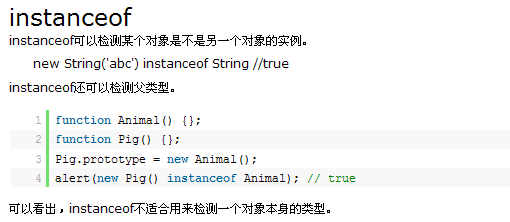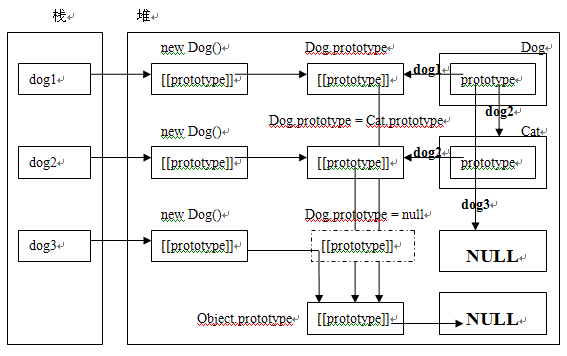理解Javascript_07_理解instanceof實現原理
編輯:關於JavaScript

那麼instanceof的這種行為到底是如何實現的呢,現在讓我們揭開instanceof背後的迷霧。
instanceof原理
照慣例,我們先來看一段代碼:
復制代碼 代碼如下:
function Cat(){}
Cat.prototype = {}
function Dog(){}
Dog.prototype ={}
var dog1 = new Dog();
alert(dog1 instanceof Dog);//true
alert(dog1 instanceof Object);//true
Dog.prototype = Cat.prototype;
alert(dog1 instanceof Dog);//false
alert(dog1 instanceof Cat);//false
alert(dog1 instanceof Object);//true;
var dog2= new Dog();
alert(dog2 instanceof Dog);//true
alert(dog2 instanceof Cat);//true
alert(dog2 instanceof Object);//true
Dog.prototype = null;
var dog3 = new Dog();
alert(dog3 instanceof Cat);//false
alert(dog3 instanceof Object);//true
alert(dog3 instanceof Dog);//error
讓我們畫一張內存圖來分析一下:

內存圖比較復雜,解釋一下:
程序本身是一個動態的概念,隨著程序的執行,Dog.prototype會不斷的改變。但是為了方便,我只畫了一張圖來表達這三次prototype引用的改變。在堆中,右邊是函數對象的內存表示,中間的是函數對象的prototype屬性的指向,左邊的是函數對象創建的對象實例。其中函數對象指向prototype屬性的指針上寫了dog1,dog2,dog3分別對應Dog.prototype的三次引用改變。它們和棧中的dog1,dog2,dog3也有對應的關系。(注:關於函數對象將在後續博文中講解)
來有一點要注意,就是dog3中函數對象的prototype屬性為null,則函數對象實例dog3的內部[[prototype]]屬性將指向Object.prototype,這一點在《理解Javascript_06_理解對象的創建過程》已經講解過了。
結論
根據代碼運行結果和內存結構,推導出結論:
instanceof 檢測一個對象A是不是另一個對象B的實例的原理是:查看對象B的prototype指向的對象是否在對象A的[[prototype]]鏈上。如果在,則返回true,如果不在則返回false。不過有一個特殊的情況,當對象B的prototype為null將會報錯(類似於空指針異常)。
這裡推薦一篇文章,來自於歲月如歌,也是關於instanceof原理的,角度不同,但有異曲同工之妙。
小編推薦
熱門推薦